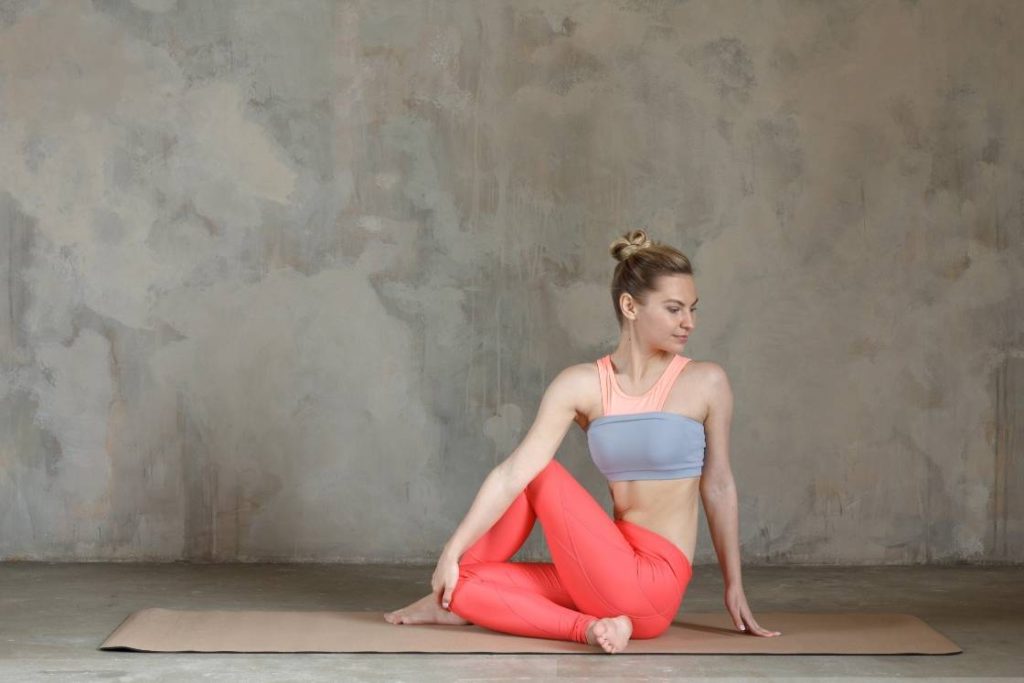
A Hindu legendary Sage Matsyendranath, one of the founders of Hath Yoga, used to meditate in a unique pose. This pose later popularized as one of 15 poses of Hatha Yoga and known by Matsyendrasana or Lord of the fishes pose.
Ardha Matsyendrasana is a mild twisting pose performed swirling the spine. However its benefits are not limited to spine flexibility but to uplift the physical, mental, and emotional well-being.
To come into Ardha Matsyendrasana, from dandasana, the right knee is bent to place the foot around the left hip. The left knee is raised placing the left foot beside the outer right knee. The neck is then twisted looking to the left. The right arm is extended outside the left knee to grab the left foot. The twist is enhanced by wrapping the left arm around the back to place the hand on the right thigh.
No matter how challenging it might seem to you, there are several variations to try as per your potential.
Meaning
Ardha Matsyendrasana is a derivative of the fuller pose, matsyendrasana (Purna matsyendrasana) named after the hath yoga revivalist, Yogi Matsyendranath [efn_note] Matsyendra https://en.wikipedia.org/wiki/Matsyendra [/efn_note]. Due to its challenging nature, Ardha matsyendrasana has been proposed.
In Sanskrit, “Ardha” means “half”, “matsyendra” is “king of fishes”, and “asana” refers to “pose”. As it is an easier variant or half as tough as matsyendrasana, hence the name.
People also refer to it by its English name, Half Lord of Fishes Pose. Sometimes, it is also known as the Half Spinal Twist pose, as it twists half of the spine performing the pose on one side at a time.
In some texts, it is found by the name of Vakrasana. In Sanskrit, “vakra” means “twisted” and “asana” refers to “pose”. As it twists the body while performing the pose, hence also referred so.
Mythology Behind the Pose

The mythological tale associated with Ardha matsyendrasana is about Lord Shiva describing the yoga mysteries to Parvati (his consort). He took Parvati to a secluded island to describe yoga, a fish on the shore heard the conversation with concentration and remained still throughout.
As soon as Shiva realized the fish has learned yoga, he sprinkled some water upon it. It enlightened the fish and it got into its divine form of Matsyendra (king of fishes). Matsyendra later returned to earth to spread yoga and take others to their spiritual paths.
Some practitioners also have a perception that while holding the pose, the lower half of the body resembles the fish and another half the human. This shows the divine hybrid form of yogi Matsyendranath.
Ardha Matsyendrasana Practice Guide
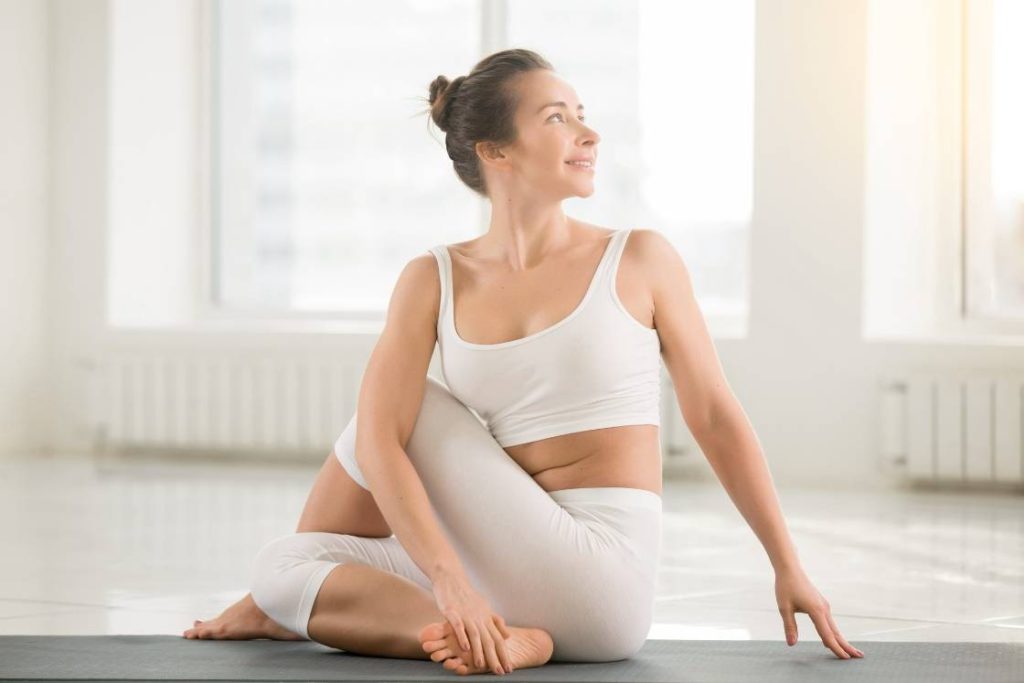
Contraindications
- Avoid this pose during pregnancy and menstruation.
- Do not try ardha matsyendrasana in case of severe back pain.
- Avoid it if there is any spinal issue or slipped disk.
- Refrain its practice in case of heart, abdomen, or brain surgery.
- People suffering from peptic ulcers should not perform this asana.
- Any injury in the knee, hip, shoulders, neck, or back might worsen practicing this pose.
Preparatory Poses
- Bound Angle Pose (Baddha Koṇasana)
- Head-to-Knee Forward Bend (Janu sirsasana)
- Hero Pose (Virasana)
- Bharadvaja’s Twist (Bharadvajasana)
- Reclined Hand to Big Toe Pose (Supta Padangusthasana)
- Marichy Sage Twist Pose (Marichyasana)
How to Do Ardha Matsyendrasana (Steps)
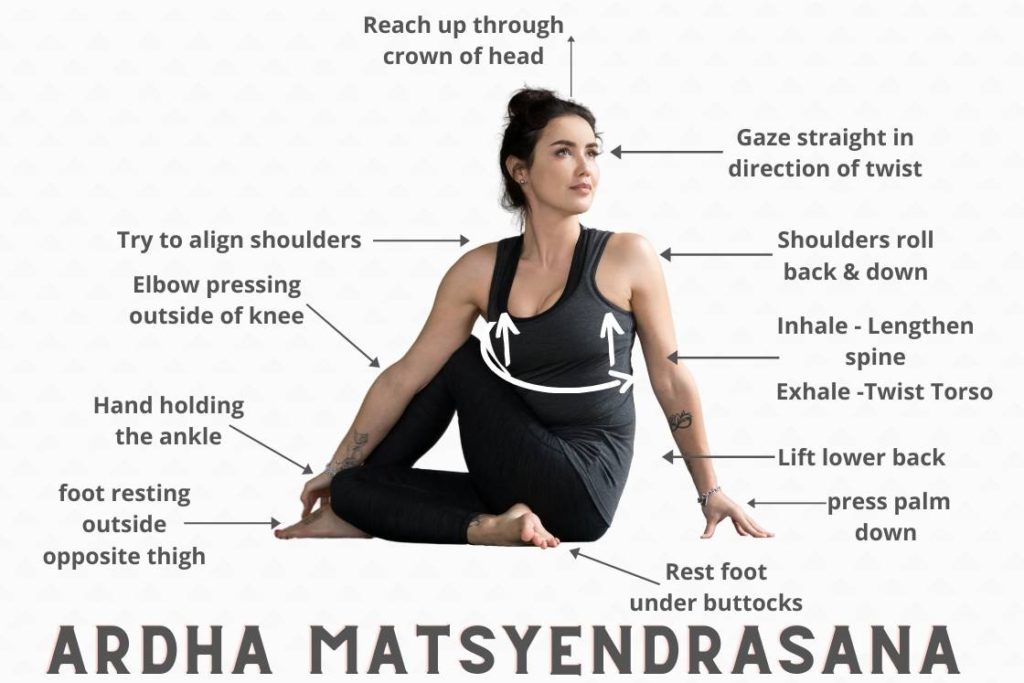
- Begin by sitting stright in dandasana.
- Flex the right knee to place the right foot outside the left knee.
- Bending the left knee bring the left foot around the right hip.
- Inhale raising the left arm and with an exhalation twisting the torso pass it around the outer edge of the right knee.
- Hold the right foot with the left hand such that the right knee lies closer to the left armpit.
- Inhale, maintaining the back integrity, raise the right arm in the front and gaze towards its fingertips. Exhale to continue the twisting towards the right to look past the right shoulder.
- Inhale sit up and exhale bend the right elbow to reach the left side of the waist wrapping the right arm around the back.
- Release the posture in reverse order and then repeat the steps to the left side.
Precautions
- Keep your shoulders square and spine erect while holding the pose.
- Ensure that the buttocks and foot corresponding to the raised knee are firm on the ground.
- Avoid slouching on your back or straining the neck holding the posture.
Follow-up poses
- Paschimottanasana (Seated Forward Bend)
- Head-to-Knee Forward Bend (Janu Sirsasana)
Props and Modifications
By using the following props you can deepen the ardha matsyendrasana twist. Also, It will prevent muscle straining that can occur in the pose;
- Using Yoga strap – Bind a yoga strap around the lower thigh or shin. While performing the twist grab the strap from the alternative hand. It will add length to your hand behind the back. It eases the pose reach the lower foot to perform the twist.
- Blocks – Place a yoga block under your hips and then practice the asana. Place another block behind you. If drawing the arm backward and wrapping around the waist is difficult then rest the backward hand on the block.
Variations
Choose from following variations to ease or advance your ardha matsyendrasana practice;
1. Ardha Matsyendrasana 1
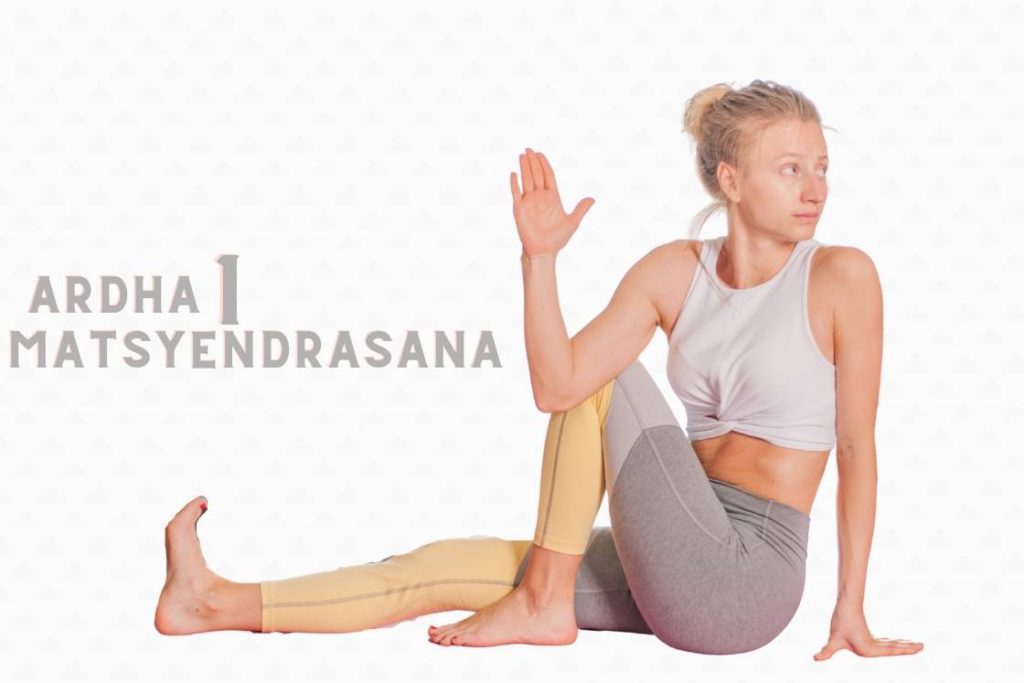
This variation is suitable for beginners who have knee problems or can’t sit Vajrasana at the beginning of the pose. In this case, one can simply keep one leg extended straight in Dandasana and perform Ardha Matsyendrasana 1.
Sit tall, legs extended straight in front of you in Dandasana. From Dandasana, bend your right knee to place the right foot next to the left knee. Drop your right hand behind you. Inhale, stretch your left hand up, push the right knee, hold the right ankle, and look back.
2. Ardha matsyendrasana Hands Up Variation
It is an easier variation of Ardha matsyendrasana for those who don’t want to twist the spine deep in this pose.
Sit in vajrasana, drop your buttocks to the right on the floor. Draw the left foot to the outside of the right knee using the hands. Take your left hand behind you and raise the right arm. Drop it down from the outside of the left knee and hold the left ankle with the right hand. Turn to look beyond the left shoulder.
2. Ardha Matsyendrasana 2
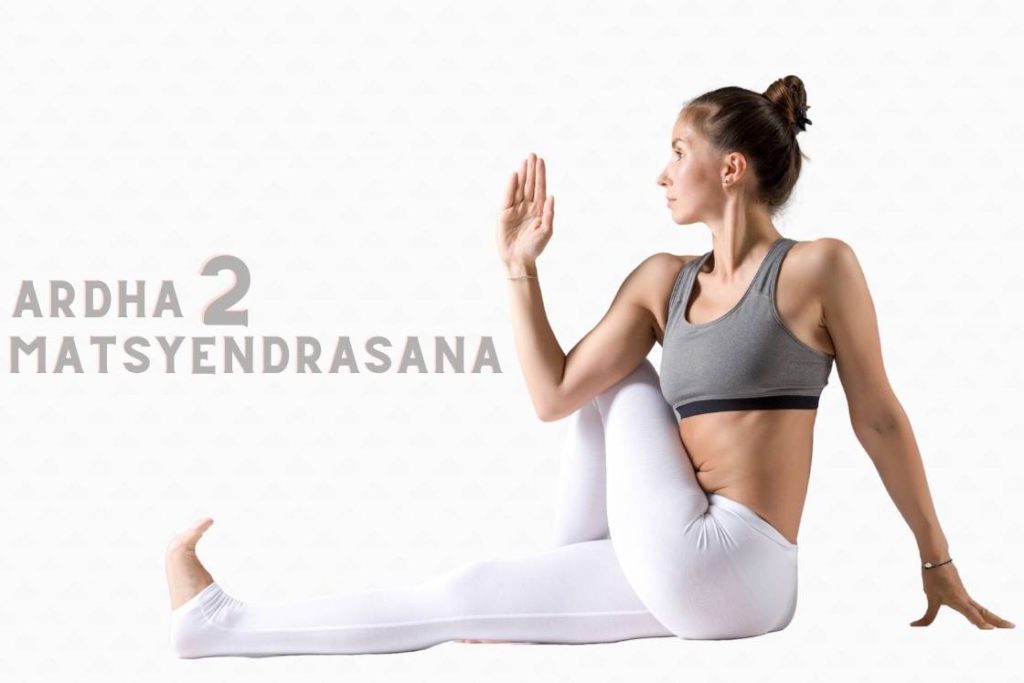
Ardha Matsyendrasana 2 is different from Ardha Matsyendrasana 1 in terms of placement of the foot. Here, the bent leg takes over the opposite leg, and the foot is placed outside of the opposite knee. It adds more benefits to the 1st variation of this pose.
From dandasana bend your right knee to place the right foot over the root of the left thigh. Then once again, draw the left arm backward wrapping it around the waist to grab the right ankle or shin. Hold the left big toe or sole from outside with right arm.
3. Ardha Matsyendrasana 3
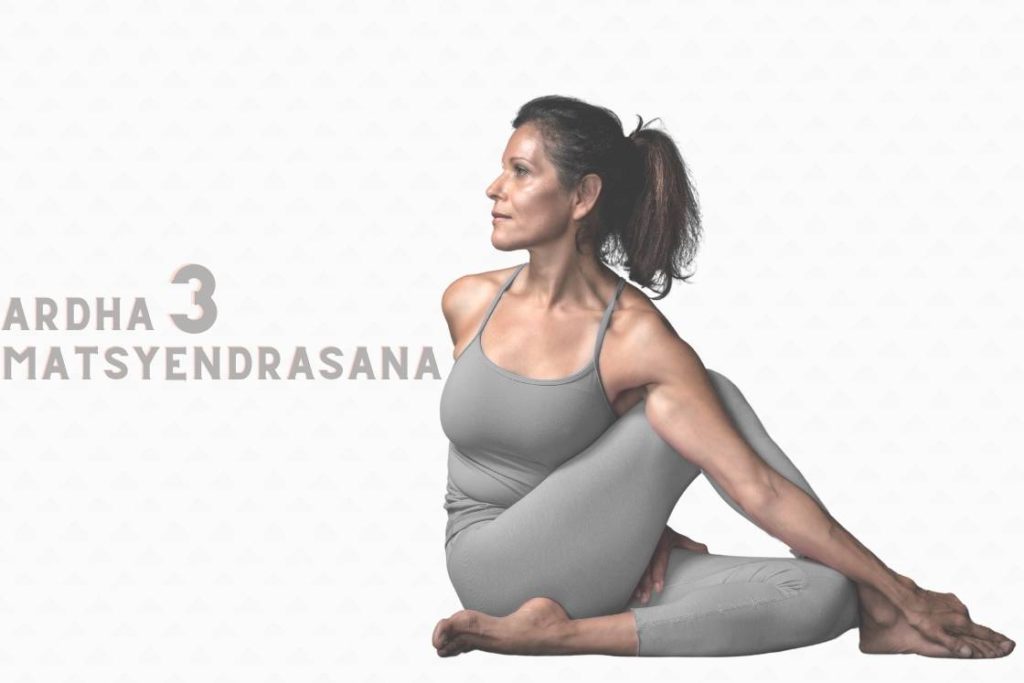
Deepen the pose further, in Ardha Matsyendrasana 3 the leg we kept straight in previous variations is bent to bring it under the opposite hip. It’s the same as the main pose described above in the article.
From dandasana, bend the left knee to place the left foot at the root of the right thigh. Flex the right knee and bring the right foot to the floor beside the outer left knee. Twisting the trunk to the right press the outer right knee against the left arm. Hold the right ankle with the left hand. Wrap the right arm around the back resting the hand on the waist.
4. Full Matsyendrasana
Also called Purna Matsyendrasana. In this pose, unlike other ardha matsyendrasana variations the foot is not placed under buttocks instead bent foot’s heel pressed against navel.
Sit with leg position similar to ardha matsyendrasana III. Swing the right arm around the back to hold the left ankle with the right hand. Twist further to the right to bring the left shoulder over the outer right knee. Hold the right foot with the left hand and turn the neck to look towards the right.
Therapeutic Benefits
- Ardha matsyendrasana is an intense stretch that is beneficial to get rid of any stiffness between the vertebrae. It strengthens the spine and hence improves the posture.
- It also relieves back pain and is effective to cure sciatica. [efn_note] efficacy of yogasana in the management of grudhrasi (sciatica) https://www.researchgate.net/profile/Manish_Arora8/publication/331035235_EFFICACY_OF_YOGASANA [/efn_note]
- People experiencing minor slip disk can get relief from this spinal twisting pose.
- It can be used as a remedial pose to treat the issue of constipation.
- Practice this pose to improve the posture as it can rectify the rounded shoulders.
- The pancreas is squeezed while twisting the torso. It focuses on the pancreas and stimulates its efficiency, hence beneficial in curing diabetes. [efn_note] A Study on the Effect of Yogic intervention on serum glucose level on Diabetics http://indianyoga.org/wp-content/uploads/2013/02/v1-issue1-article9.pdf [/efn_note]
- This pose stimulates the kidney and liver. Hence it is beneficial in curing urinary tract infections (UTI) and other nephrotic disorders. [efn_note] a review on comprehensive overview in the management of nephrotic disorders http://www.jcreview.com/fulltext/197-1572427040.pdf [/efn_note]
Ardha Matsyendrasana Benefits
1. Stretches arms, shoulders, and spine
Besides being a spinal twist ardha matsyendrasana stretches the arms, shoulders, and chest muscles. This improves the flexibility of the upper body. It also strengthens these muscles and makes the spine supple.
2. Strengthens leg muscles
The leg muscles are also kept stretched and twisted while holding the pose. It strengthens the hamstrings, calves, ankles, and knee muscles by improving blood circulation.
3. Stimulates abdominal muscles
The torso is twisted that stretches and expands the abdominal muscles. Also, it provides massaging effects on internal organs, like the kidney, liver, stomach, and spleen. This benefits all the involved muscles and anatomical organs. Therefore it is a great stretch to tone the abdomen.
4. Improves digestion
Ardha matsyendrasana involves twisting of the torso. It leaves a massaging effect on the internal organs enhancing the blood flow towards them. It eventually aids in better digestion.
5. Enhances breathing capacity
This posture is a chest opener. It expands the chest muscles along with the lungs. This helps in increased intake of oxygen and improves the functioning of the respiratory system.
It is evident from a study in 2006 [efn_note] yoga exercise increases chest wall expansion and lung volumes in young healthy thais http://citeseerx.ist.psu.edu/viewdoc/download?doi=10.1.1.398.8987&rep=rep1&type=pdf [/efn_note] that ardha matsyendrasana is effective in enhancing the lungs volume and better respiration.
6. Stimulates the circulatory system
While stretching the chest muscles it gently massages the heart and enhances its efficiency. This improves the blood circulation of the body. Also, the spleen is stimulated during its practice, therefore the blood purification and detoxification process are enhanced.
7. Improves reproductive health
This asana involves stretching of the pelvic regions. It secretes the stress hormone and increases the supply of blood, nutrients, and oxygen to the reproductive organs. Therefore, practicing this pose improves reproductive health.
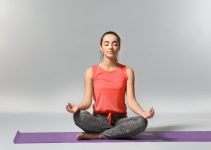
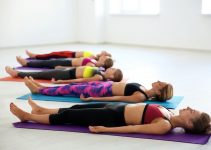
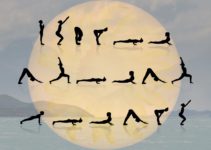


Thank you for sharing such a detailed guide on Ardha Matsyendrasana! I love how you’ve explained the benefits and steps so clearly. I’m excited to incorporate this pose into my practice for better spinal flexibility and detoxification. Looking forward to more such informative posts!
I loved reading this post on Ardha Matsyendrasana! The detailed explanation of its benefits and step-by-step instructions made it easy to understand and incorporate into my practice. I especially appreciated the emphasis on alignment and breathing techniques. Thank you for sharing such valuable insights!
Can Prostate enlargement be improved by Ardha Matsyendrasana? Pl guide
Pl guide whether Hypo Thyroid persons can practise Ardha matsyendradana